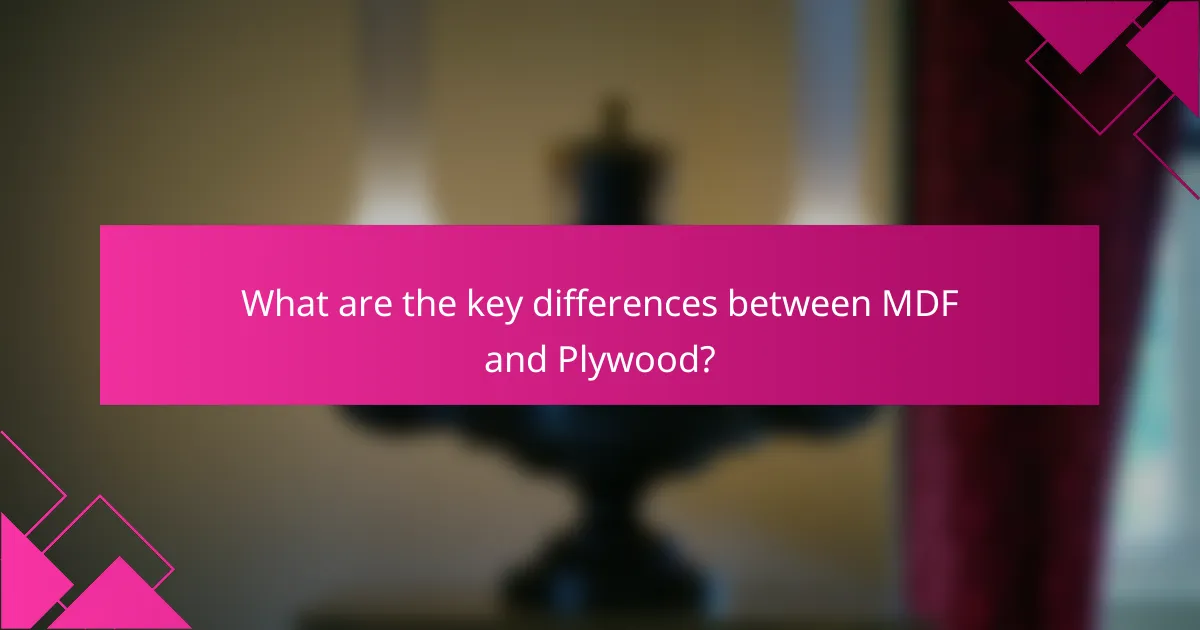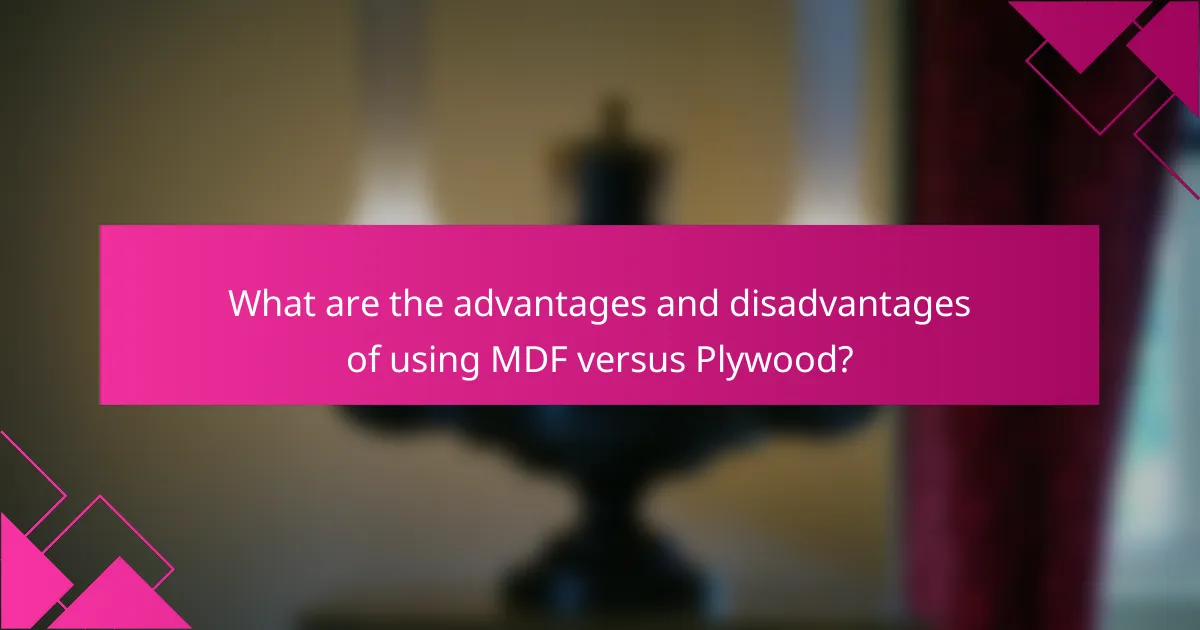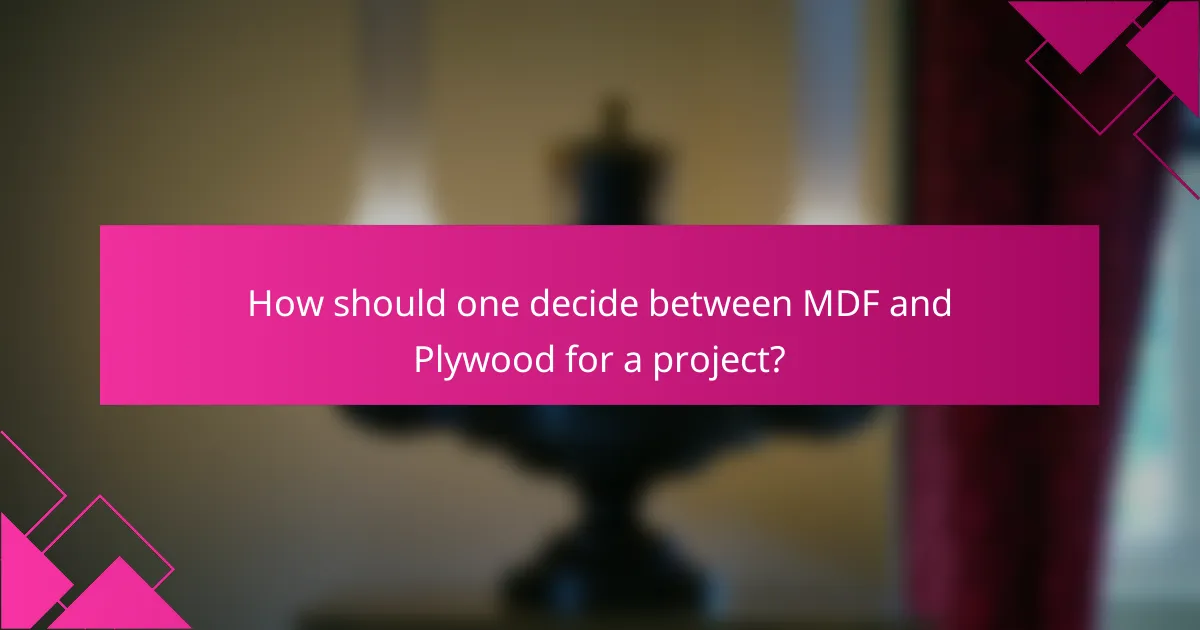MDF (Medium-Density Fiberboard) and plywood are two distinct materials used in woodworking, each with unique properties and applications. MDF is composed of wood fibers bonded with adhesive, resulting in a smooth surface ideal for painting and intricate designs, while plywood consists of thin layers of wood veneer glued together, offering greater strength and moisture resistance. This article examines the key differences between MDF and plywood, focusing on aspects such as cost, durability, and suitability for various projects. It highlights the advantages and disadvantages of each material, guiding readers in making informed decisions based on their specific project requirements.

What are the key differences between MDF and Plywood?
MDF and plywood differ primarily in composition and construction. MDF, or Medium-Density Fiberboard, is made from wood fibers bonded with adhesive under heat and pressure. Plywood consists of thin layers of wood veneer glued together in alternating grain directions.
MDF has a smooth surface, making it ideal for painting and detailed machining. Plywood is stronger and more resistant to warping due to its layered construction. MDF is generally less expensive than plywood, which can be costlier depending on the wood species used.
In terms of durability, plywood can handle moisture better than MDF, which can swell and lose integrity when exposed to water. Plywood is often preferred for structural applications, while MDF is commonly used for furniture and cabinetry. These differences highlight the suitability of each material for specific projects.
How does the cost of MDF compare to Plywood?
MDF is generally cheaper than plywood. The cost of MDF typically ranges from $30 to $50 per sheet, depending on thickness and quality. In contrast, plywood costs between $50 and $100 per sheet, influenced by wood type and grade. MDF’s lower price is due to its manufacturing process, which uses wood fibers and adhesives. Plywood, made from thin layers of wood veneer, is more labor-intensive to produce. The price difference can be significant for large projects. Therefore, choosing between MDF and plywood often involves considering budget constraints.
What factors influence the pricing of MDF and Plywood?
The pricing of MDF and plywood is influenced by several key factors. These include the type of wood used, production methods, and thickness. The quality of raw materials directly impacts costs. For example, hardwood plywood typically costs more than softwood alternatives. Additionally, manufacturing processes play a significant role in pricing. Higher production standards often lead to increased costs. Market demand also affects pricing; when demand rises, prices tend to increase. Geographical location influences transportation costs, impacting overall pricing. Seasonal variations can affect supply, leading to price fluctuations. Lastly, brand reputation can result in price differences between manufacturers.
Are there significant price variations based on quality?
Yes, there are significant price variations based on quality. Higher quality plywood typically costs more than lower quality options. For instance, marine-grade plywood is more expensive due to its durability and resistance to moisture. Conversely, MDF is generally less expensive than high-quality plywood. The price difference can range from 20% to 50% depending on the grade and intended use. Quality impacts not only the cost but also the longevity and performance of the materials.
What are the durability characteristics of MDF and Plywood?
MDF (Medium-Density Fiberboard) and plywood have distinct durability characteristics. MDF is less durable than plywood. It is more susceptible to water damage and can swell when exposed to moisture. Plywood is known for its strength and resistance to warping. It withstands moisture better due to its layered construction. Plywood’s durability makes it suitable for structural applications. MDF is often used for decorative purposes where strength is less critical. Studies show that plywood can support heavier loads compared to MDF. Therefore, plywood is generally preferred for applications requiring higher durability.
How does moisture resistance differ between MDF and Plywood?
MDF has lower moisture resistance compared to plywood. MDF is made from wood fibers bonded with adhesives, making it susceptible to swelling and deformation when exposed to moisture. Plywood, on the other hand, consists of multiple layers of wood veneer glued together, which provides better structural integrity and moisture resistance. Plywood can withstand higher humidity levels and is less likely to warp or delaminate. This difference is significant in applications where exposure to moisture is a concern, such as in kitchens or bathrooms.
In what ways do MDF and Plywood handle wear and tear?
MDF and plywood handle wear and tear differently due to their material composition. MDF, made from wood fibers and adhesives, is less resistant to moisture and physical impacts. This makes it prone to swelling and damage over time in humid conditions. Plywood, constructed from thin layers of wood veneer, offers greater durability and resistance to moisture. Its layered structure provides enhanced strength and flexibility, making it less likely to crack or warp under stress. Studies show that plywood can withstand heavier loads and impacts compared to MDF, making it a preferred choice in high-traffic areas.
What applications are best suited for MDF and Plywood?
MDF is best suited for applications requiring smooth surfaces and intricate designs, such as cabinetry and furniture. It is also ideal for decorative moldings and wall panels due to its ease of machining. Plywood, on the other hand, is preferred for structural applications like flooring, roofing, and wall sheathing. Its strength and durability make it suitable for furniture, cabinetry, and outdoor projects. Both materials are widely used in construction and woodworking industries for their unique properties.
What types of projects typically use MDF?
MDF is commonly used in furniture projects, cabinetry, and decorative moldings. It is favored for its smooth surface, which is ideal for painting and veneering. Additionally, MDF is often utilized in crafting, such as for making intricate designs or prototypes. Its density allows for detailed cuts and shapes, making it suitable for various artistic applications. Furthermore, MDF is frequently employed in interior applications like wall panels and shelving. Its affordability compared to solid wood makes it a popular choice for budget-conscious projects.
What types of projects benefit most from Plywood?
Plywood is particularly beneficial for construction, cabinetry, and furniture projects. Its strength and versatility make it ideal for structural applications. Plywood can withstand heavy loads and resist warping, which is crucial in building frameworks. It is also used in making cabinets due to its smooth surface and ease of finishing. Furniture projects benefit from plywood’s durability and aesthetic appeal. Additionally, plywood is commonly utilized in flooring and wall sheathing. Its layered construction provides stability and reduces the risk of splitting. Overall, plywood is favored in various projects that require strength and reliability.

What are the advantages and disadvantages of using MDF versus Plywood?
MDF offers a smooth surface and is easier to work with than plywood. It is less prone to warping and splitting. MDF is also generally cheaper, making it a cost-effective choice for many projects. However, MDF is more susceptible to moisture damage and is heavier than plywood. Plywood, on the other hand, is stronger and more durable. It has better resistance to moisture and is lighter, making it suitable for applications like furniture and cabinetry. The disadvantages of plywood include a rougher surface and a higher cost compared to MDF.
Why might one choose MDF over Plywood?
MDF is often chosen over plywood for its smooth surface and ease of machining. This makes MDF ideal for applications requiring intricate designs or detailed finishes. MDF has a uniform density, which results in fewer imperfections compared to plywood. This uniformity allows for consistent results when cutting or shaping the material. Additionally, MDF is generally less expensive than high-quality plywood. Its affordability makes it a popular choice for budget-conscious projects. Furthermore, MDF does not warp or splinter as easily as plywood, providing better durability in certain conditions. These factors contribute to the preference for MDF in specific woodworking and crafting scenarios.
What are the specific benefits of MDF in furniture making?
MDF, or Medium Density Fiberboard, offers several specific benefits in furniture making. It provides a smooth surface ideal for painting and veneering. This smoothness enhances the aesthetic appeal of finished products. MDF is also more affordable than solid wood and plywood. Its cost-effectiveness makes it a popular choice for budget-conscious projects.
Additionally, MDF is highly versatile and can be easily cut and shaped. This flexibility allows for intricate designs and details in furniture. MDF does not warp or crack like solid wood, ensuring durability over time. Furthermore, it is made from recycled wood fibers, making it an environmentally friendly option. These attributes make MDF a preferred material for various furniture applications.
How does the finishing process differ for MDF and Plywood?
The finishing process for MDF and plywood differs significantly. MDF typically requires sanding and sealing before painting or varnishing. This is due to its smooth surface and porosity. Plywood, on the other hand, often needs less sanding because of its layered construction. Plywood can be finished directly with stains or sealants. MDF absorbs paint more readily, resulting in a smoother finish. Plywood’s grain can show through stains, adding texture. These differences arise from their material compositions. MDF is dense and uniform, while plywood is made of multiple wood layers. This affects the types of finishes that can be applied effectively.
What are the potential drawbacks of using MDF compared to Plywood?
MDF has several potential drawbacks compared to plywood. MDF is denser and heavier, making it less convenient for certain applications. It is also more susceptible to moisture damage, leading to swelling and warping. Additionally, MDF emits formaldehyde, which can pose health risks if not properly managed. Plywood, on the other hand, is more durable and can withstand higher levels of stress and impact. Its layered construction provides better resistance to bending and cracking. MDF’s lack of natural grain makes it less appealing for visible applications, while plywood offers aesthetic versatility. These factors highlight the limitations of MDF when compared to plywood in various uses.
Are there health concerns associated with MDF?
Yes, there are health concerns associated with MDF. Medium-density fiberboard (MDF) contains formaldehyde, a known irritant and potential carcinogen. Prolonged exposure to formaldehyde can lead to respiratory issues and skin irritation. The World Health Organization has classified formaldehyde as a Group 1 carcinogen. Additionally, MDF dust can be harmful when inhaled, leading to respiratory problems. Proper ventilation and protective equipment are recommended during MDF handling and cutting.
How does the environmental impact differ between MDF and Plywood?
MDF and plywood have different environmental impacts primarily due to their materials and production processes. MDF is made from wood fibers bonded with adhesives, which can emit volatile organic compounds (VOCs). This process often involves the use of urea-formaldehyde, a chemical linked to indoor air pollution. In contrast, plywood consists of thin layers of wood veneer glued together, usually with less harmful adhesives.
The production of MDF typically requires more energy and resources compared to plywood. Studies show that plywood can be more sustainable when sourced from responsibly managed forests. Additionally, plywood is biodegradable, while MDF may take longer to decompose due to its adhesive content.
Overall, plywood generally has a lower environmental footprint than MDF, especially when considering the sourcing and degradation of materials.

How should one decide between MDF and Plywood for a project?
To decide between MDF and plywood for a project, consider the specific requirements of your project. MDF, or Medium Density Fiberboard, offers a smooth surface ideal for painting and intricate designs. It is denser and heavier than plywood, which can be beneficial for stability in certain applications. Plywood, on the other hand, is made from thin layers of wood veneer. It provides greater strength and durability, making it suitable for structural applications.
Cost is another factor. MDF is generally less expensive than plywood, which can be a deciding factor for budget-conscious projects. However, plywood often has better longevity in high-moisture environments.
Evaluate the project’s intended use. For furniture and cabinetry, MDF may be preferable due to its finish quality. For outdoor or load-bearing projects, plywood is the better choice due to its resilience.
These distinctions guide the decision-making process effectively.
What factors should be considered when choosing between MDF and Plywood?
When choosing between MDF and plywood, consider durability, cost, and application. MDF is denser and smoother, ideal for intricate designs. Plywood is stronger and more resistant to moisture, making it suitable for structural uses. Cost differences are significant; MDF is often cheaper than plywood. However, plywood’s durability may justify its higher price in certain projects. Additionally, consider the environmental impact; plywood is generally more eco-friendly due to its natural wood composition. Each material has its unique attributes that suit different needs and preferences.
How do project requirements influence the choice of material?
Project requirements significantly influence the choice of material by dictating factors such as cost, durability, and application suitability. For instance, if a project demands a cost-effective solution, MDF may be preferred due to its lower price compared to plywood. Conversely, if durability is a priority, plywood, known for its strength and resistance to moisture, may be selected. Specific applications also guide material choice; MDF is often used for intricate designs while plywood is favored for structural applications. The project’s intended use, environmental conditions, and budget constraints shape these decisions. Thus, understanding project requirements is essential for selecting the appropriate material.
What budget considerations should be taken into account?
When budgeting for MDF and plywood, consider the initial material costs. MDF typically costs less than plywood, making it budget-friendly for large projects. However, factor in potential additional expenses for finishing MDF, as it may require more paint or veneer. Evaluate long-term durability; plywood often lasts longer, which can lead to lower replacement costs. Assess the cost of tools and equipment needed for each material, as plywood may require specialized cutting tools. Shipping and handling costs can also vary; plywood is often heavier, increasing transportation expenses. Finally, consider the project’s scale, as larger projects may benefit from bulk purchasing discounts.
What are some practical tips for using MDF and Plywood effectively?
To use MDF and plywood effectively, select the right material for your project. MDF is ideal for intricate designs due to its smooth surface. Plywood offers strength and durability for structural applications. Always cut MDF with a fine-tooth saw to prevent chipping. For plywood, use a circular saw for clean edges. Seal the edges of MDF to prevent moisture absorption. Plywood should be finished with a protective coating to enhance longevity. Use clamps when assembling both materials to ensure a tight fit. Proper storage in a dry environment prevents warping in both MDF and plywood.
How can one ensure the best results when working with MDF?
To ensure the best results when working with MDF, use proper tools and techniques. Select a fine-toothed saw for clean cuts. Apply a suitable primer before painting to enhance finish quality. Use clamps to secure pieces during assembly to prevent movement. Maintain a dust-free workspace to avoid surface imperfections. Ensure proper ventilation when sanding to minimize inhalation of dust. Store MDF in a dry environment to prevent warping. Following these practices leads to professional-quality results.
What best practices should be followed for Plywood usage?
Use plywood in a dry environment to prevent warping. Store plywood flat to maintain its shape. Seal edges and surfaces to protect against moisture. Use appropriate adhesives and fasteners for durability. Cut plywood with sharp tools for clean edges. Sand surfaces before finishing for better adhesion. Follow manufacturer guidelines for load-bearing applications. Regularly inspect for signs of damage or wear.
The main entity of this article is the comparison between MDF (Medium-Density Fiberboard) and plywood, focusing on their cost, durability, and application differences. The article outlines the distinct compositions and construction methods of both materials, highlighting MDF’s smooth surface and lower cost versus plywood’s superior strength and moisture resistance. Key factors influencing pricing, quality variations, and suitability for specific projects are discussed, along with the environmental impact and health concerns associated with MDF. Practical tips for effectively using both materials are also provided, ensuring readers can make informed decisions for their woodworking and construction projects.


